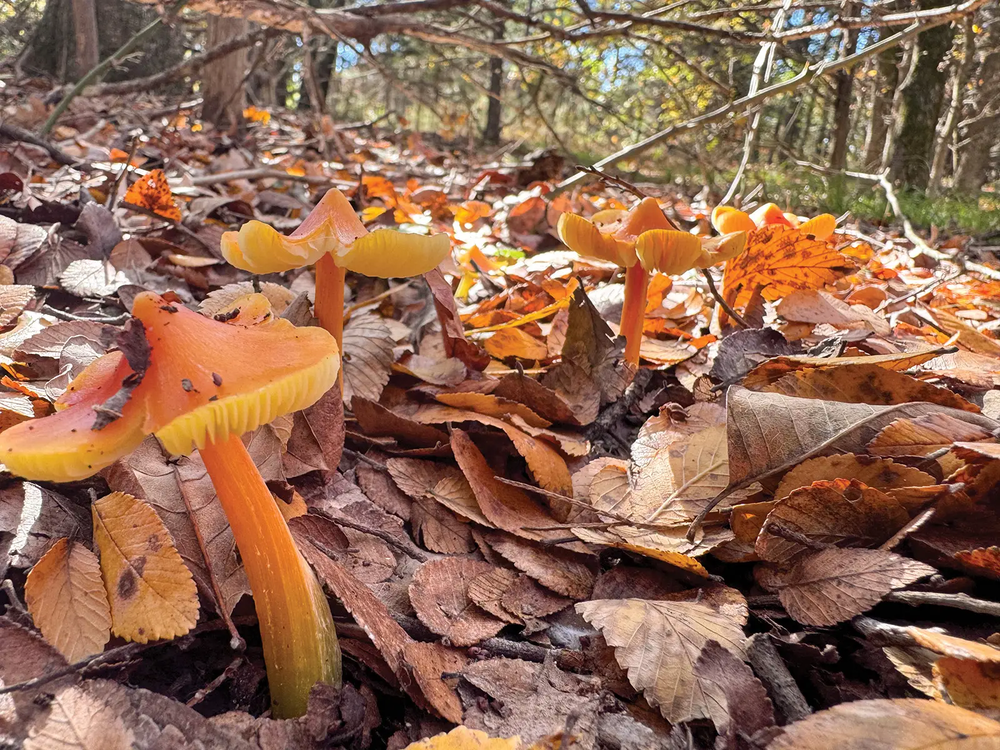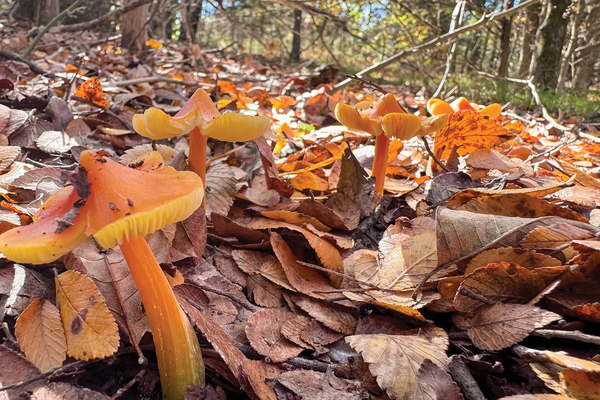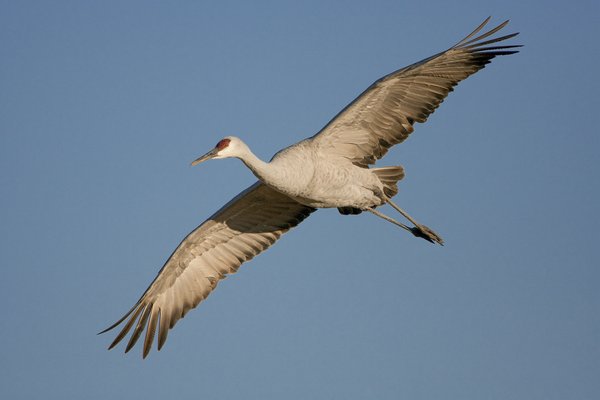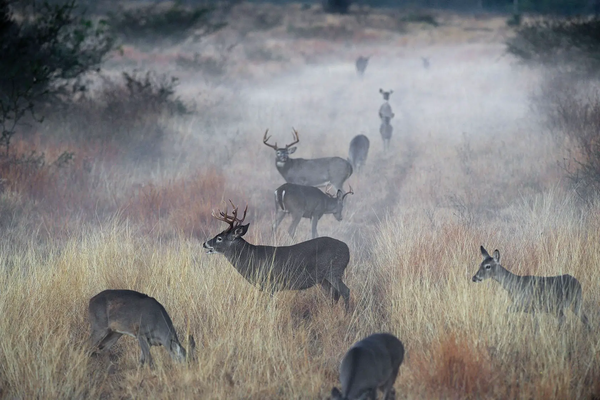It's a crisp November day when I arrive at a grassy clearing at the edge of the Caddo National Grasslands to go foraging for mushrooms. Actually, I’m worried it may be too crisp. Besides the bite in the air, there’s a distinctive crunch beneath our feet as we head into the woods.
“If the leaves crunch, it might be too dry for mushrooms,” says Sebastian Tabibi, president of the newly formed North Texas Mycological Association and our guide for the day.
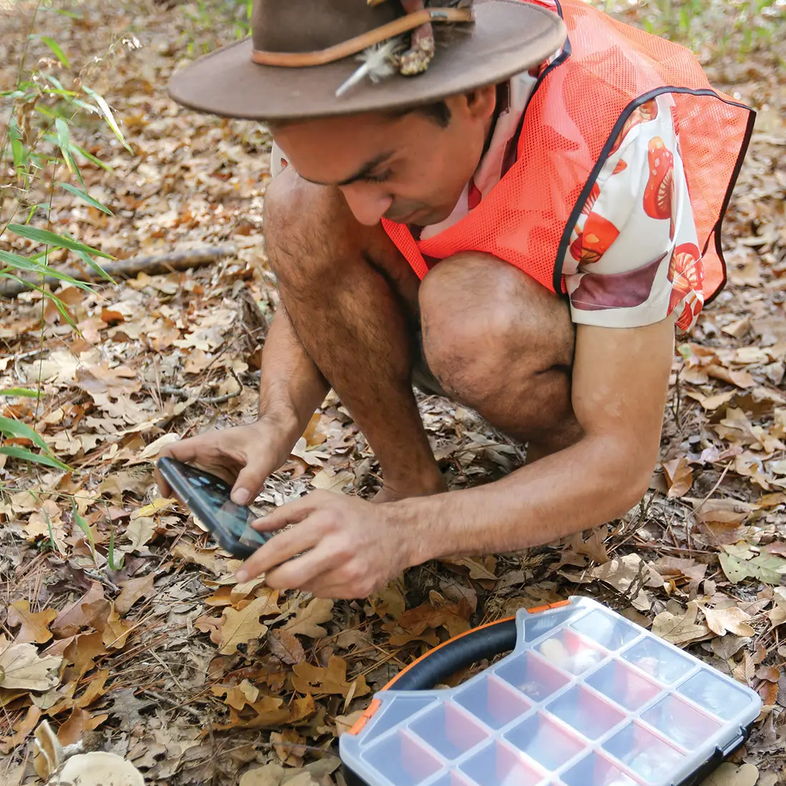
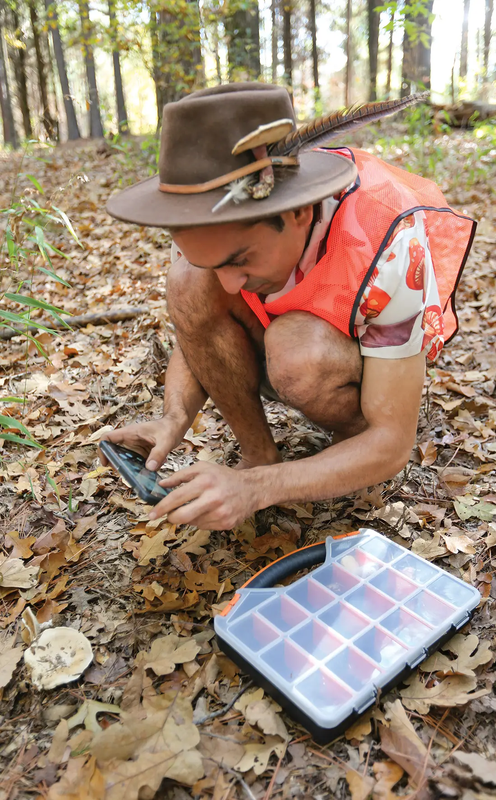
Sebastian Tabibi logs a mushroom on iNaturalist.
Sonja Sommerfeld | TPWD
Sebastian Tabibi logs a mushroom on iNaturalist.
Sonja Sommerfeld | TPWD
But within less than half an hour, we’ve already discovered several fungi growing in drifts of decomposing leaves, clinging to dead trees or poking out of mossy embankments. Some are edible, some are not; each one feels like finding a natural treasure.
Mushroom hunting can seem intimidating — with deadly lookalikes and tricky identifications, there’s more room to go wrong than with some other wild edibles. But when done right, mushroom foraging can be extremely rewarding; Texas is home to many delicious species, including morels, chanterelles, chicken of the woods, oysters and a whole buffet of others.
“People don't realize that Texas is loaded with wild mushrooms,” says Mark “Merriwether” Vorderbruggen, who runs the popular blog Foraging Texas.
Read on to learn to identify some common Texas mushrooms, find a place to forage near you, get involved in the mycology community and foray away!
Get Your 'Mushroom Eyes'
Tabibi is an appreciator of all mushrooms, not just the tasty ones. As we crunch through the forest in Caddo National Grasslands (it’s unclear to me why, exactly, this place is called a grassland, as we are in the woods the entire time) we stop for every mushroom we find and try to identify it.
This is key foraging advice: First and foremost, get familiar with your local species. You might start by investing in a mushroom field guide. David Lewis’ guide Mushrooms of the Gulf Coast States is a favorite among Texas mushroom enthusiasts. For a more foraging-specific guide, Vorderbruggen recommends 100 Edible Mushrooms by Michael Kuo.
Clicking through images on the internet can help you understand the diversity within a single species of mushroom. They can look different at different life stages, or in different times of the year.
“Spend time looking at a lot of photos, so you allow your brain to have that kind of gestalt,” says Angel Schatz, who leads the Education, Membership and Communication Circle for the Central Texas Mycological Society.
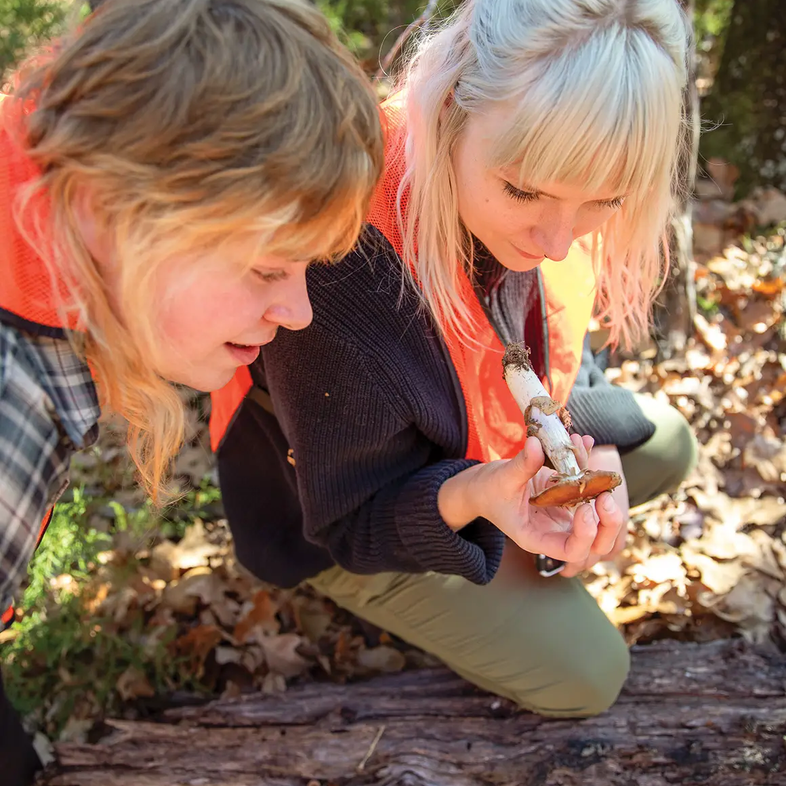
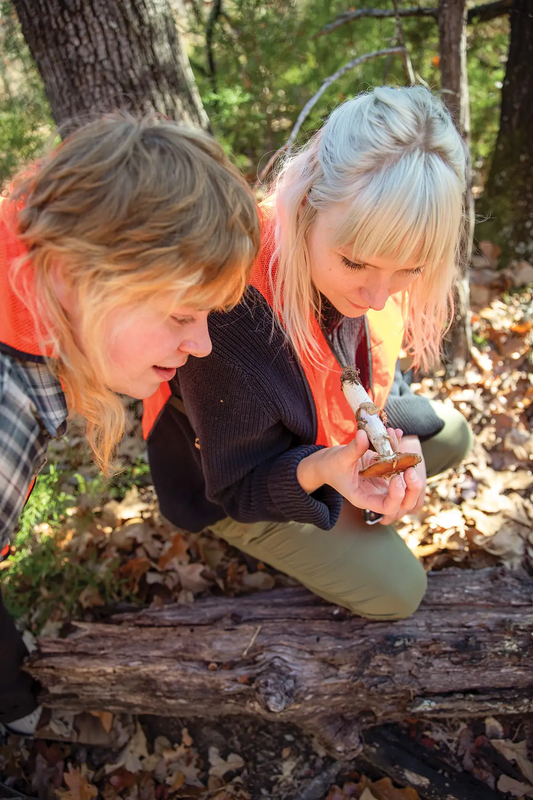
Author Eva Frederick and sister Ella Frederick examine the base of a mushroom at Caddo National Grasslands.
Maegan Lanham | TPWD
Author Eva Frederick and sister Ella Frederick examine the base of a mushroom at Caddo National Grasslands.
Maegan Lanham | TPWD
“Even going on iNaturalist — rather than doom-scrolling or reading your news, jump on iNaturalist in the morning and see what other people have been seeing,” she says. “That just helps you develop an eye — we call it ‘mushroom eyes’ — where you get really familiar with seeing them.”
Vorderbruggen advises would-be foragers to focus on a few easily identifiable fungi as they get familiar with the local array of species.
“Learn eight or 10 mushrooms and look for those,” he says. “Keep your eyes out when you’re hiking and so forth and get pictures of the rest and learn all the different structural features you need to look at to properly identify a mushroom.”
With plants, Vorderbruggen recommends matching five structural features with a field guide to get a confident identification. “With mushrooms,” he says, “it’s eight to 10. And one of the things that can involve is actually breaking it open and looking at the inside.”
Foray Away!

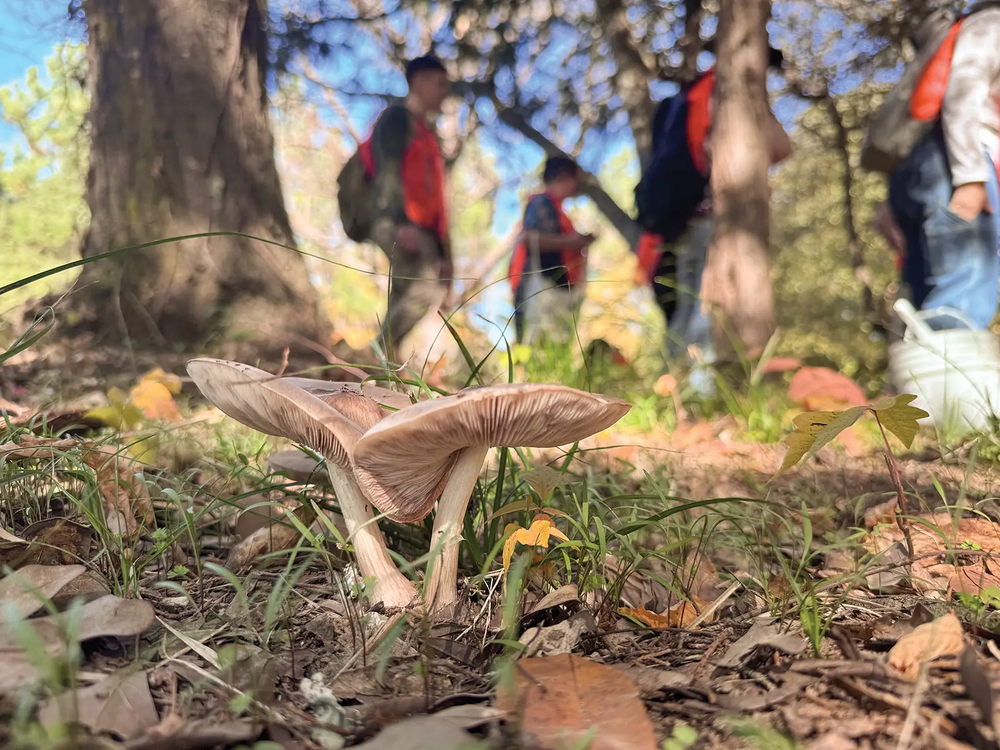
Mushrooms found during Mushgiving 2023.
Sonja Sommerfeld | TPWD
Mushrooms found during Mushgiving 2023.
Sonja Sommerfeld | TPWD
Once you've got your mushroom eyes and feel ready for a foray, Tabibi recommends setting out in search of a single species of mushroom — preferably one with no deadly lookalikes. When you have a mushroom in mind, you can familiarize yourself with its habitat.
When you’re planning a foray, timing is of the essence; depending on the species, you’ll want to head out two to four days after a soaking rain. You might set off in search of morels on a spring day in the Hill Country. They like recently burned areas, and grow in both woodlands and grasslands.
Prepare yourself by looking at photos of morels, which are known for their honeycomb-like texture. They have one lookalike, the false morel, so make sure you know the difference (true morels will be hollow all the way through, while the impostors will not). While you’re out, take photos of all mushrooms you see. If you want to, you can log them on iNaturalist.

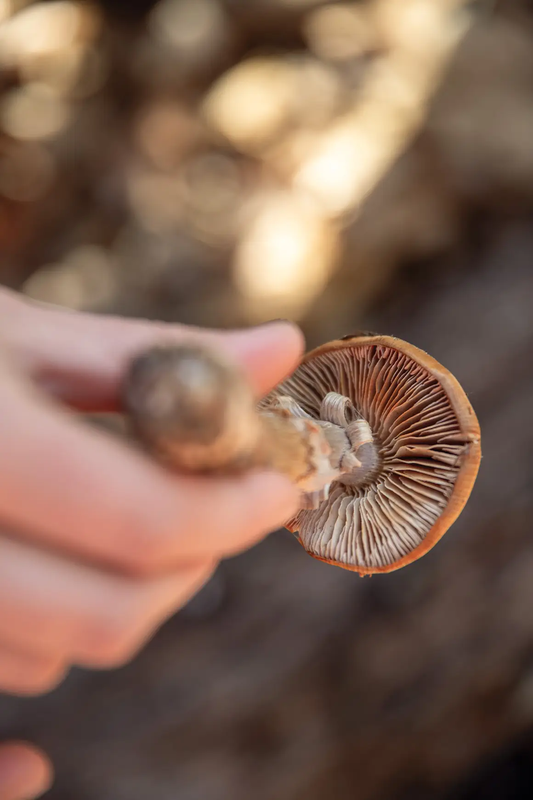
The gills are an important structural feature for identifying mushrooms.
Maegan Lanham | TPWD
The gills are an important structural feature for identifying mushrooms.
Maegan Lanham | TPWD

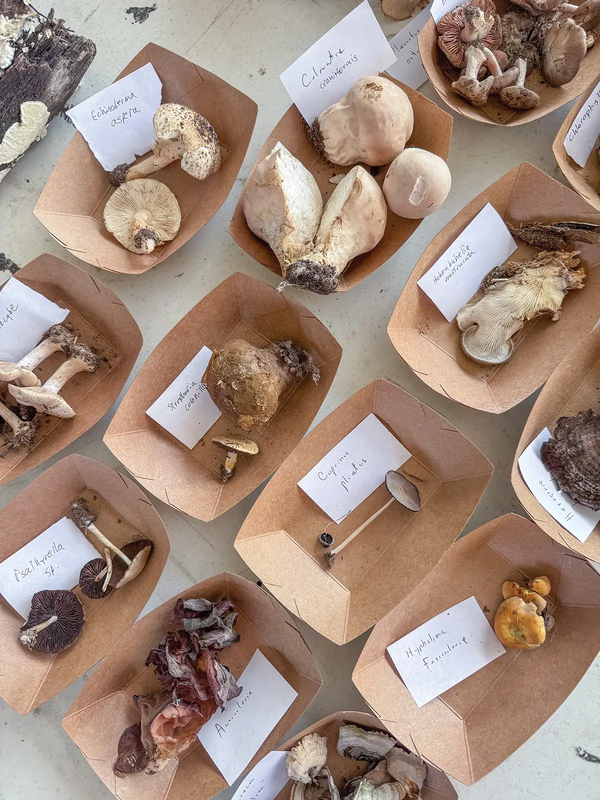
Mushroom finds with their identifications.
Sonja Sommerfeld | TPWD
Mushroom finds with their identifications.
Sonja Sommerfeld | TPWD
Or, you might choose to seek out chicken of the woods, a prized, brightly orange and yellow forest delicacy that mimics the texture of chicken. In this case, you’d want to wait a little longer after a rain — Schatz recommends four to seven days. You can recognize this one by its porous underside, bright colors and shelf-like formation.
The lion's mane mushroom is an elusive target, and will require you to set your eyes higher than other species — it typically grows on the side of trees. “I’ve seen plenty of lion’s mane way beyond reach,” says Tabibi. “If you have people around you, you can climb on each other, build a human ladder.”
Once you’ve found a mushroom that looks like your target, go through your ID checklist — is it the right time of year for this species? Do they grow in this area? Can I match enough features to my field guide? Once you’ve matched up eight to 10 structural features — these might be the color of the spores, the texture of the underside of the cap, whether the inside is hollow or filled, how far the gills run down the stem, etc. — you can feel secure in your identification.
“Take your time, but stay optimistic,” says Vorderbruggen. “It’s like in hunting, you might have heard of buck fever — when you’re waiting there and the deer comes out and suddenly you’re shaking and excited and you screw things up. Same thing with mushrooms. You get so excited and you start seeing things that aren’t there on the structures.”
Take a deep breath and be sure of your identification, he says. “No, it’s not some sort of weird mutant if a feature is missing. Take your time to identify, inhale, exhale, give thanks and then look at it again.”
If you still aren’t feeling confident about your ID, you might seek a second opinion. Mushroom identification Facebook groups can be helpful (Schatz recommends the group Texas Mushroom ID), and foragers can post their find on iNaturalist or use the associated app, Seek, to get an ID through an artificial intelligence system. Take these sources with a grain of salt, however, since people and AI are both fallible.
Where to Forage


A forager holds a colorful waxcap.
Sonja Sommerfeld | TPWD
A forager holds a colorful waxcap.
Sonja Sommerfeld | TPWD
Foraging laws in Texas can be complicated. You’re not allowed to forage in Texas state parks, and city parks and other urban areas differ depending on location. Some consider the state’s strict foraging regulations to be outdated. While some laws are in place to conserve native species, “A lot of [other] laws are rooted in the Jim Crow era, to prevent minorities from being able to have sustenance,” says Schatz.
One easy option for legal foraging is to head to one of Texas’ four national forests and two national grasslands. At Angelina, Sam Houston, Davy Crockett and Sabine national forests, you may collect up to a gallon of mushrooms per person per day for personal use. Caddo and Lyndon B. Johnson national grasslands, also managed by the National Park Service, are other places where you can legally forage without a permit.
When it comes to mushrooms on private land, it doesn’t hurt to ask. Some regions of the state have their own mycology groups, which might make permissions easier (plus, they’re typically fun, quirky and vibrant groups of people). If you’re looking for more specific foraging locations, you’ll have to get out and scout your own. “A forager,” says Schatz, “never tells their spots.”
Even in places where you have permission to harvest mushrooms, Schatz encourages foragers to consider the natural conditions as well.
“You want to think about the whole ecosystem,” she says. “We look to Indigenous ways of knowing, like honorable harvest and that sort of thing. We teach that you want to not take the first, not take the last, because not only is [that mushroom] delicious for us, it’s delicious for all of the living creatures, down to the microbes in the ecosystem. It helps the whole
forest function.”
Edible Texas Mushrooms for Beginners
LEVEL 1: These four species have distinctive appearances and no deadly lookalikes. Three of these belong to the “foolproof four,” listed by University of Minnesota professor Clyde Christiansen in his 1943 book Common Edible Mushrooms (of North America). Consider this the Texas version, since instead of lion's mane, the original list features giant puffballs, which do not grow in our state.
LEVEL 2: These mushrooms have some lookalikes, but can be distinguished by a beginner.
